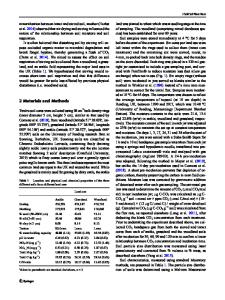Soil respiration in seven types of temperate forests exhibits similar temperature sensitivity
- PDF / 604,716 Bytes
- 8 Pages / 595.276 x 790.866 pts Page_size
- 17 Downloads / 316 Views
SOILS, SEC 3 • REMEDIATION AND MANAGEMENT OF CONTAMINATED OR DEGRADED LANDS • RESEARCH ARTICLE
Soil respiration in seven types of temperate forests exhibits similar temperature sensitivity Beata Klimek 1 & Marcin Chodak 2 & Maria Niklińska 1 Received: 14 April 2020 / Accepted: 17 September 2020 # The Author(s) 2020
Abstract Purpose The aim of the study was to compare the temperature sensitivity of soil respiration rate in two soil horizons of seven types of temperate forests. Materials and methods Soil samples were collected in O and A horizons in seven types of temperate forests, each one represented by five independent stands distributed throughout Poland. Soil respiration rates were measured at standard moisture in five temperatures (4 °C, 10 °C, 16 °C, 22 °C and 28 °C), and the first-order Q10 values were calculated for each stand. General linear models (GLM) were fitted for respiration rate and for Q10 values separately using selected soil physical-chemical properties: C:N ratio, dissolved organic carbon (DOC) content and soil pH. Results and discussion The soil respiration rate increased with temperature was the highest in O horizon of fresh mixed forest dominated by hornbeam and increased with C:N ratio, DOC content and soil pH (model p < 0.0001). In turn, model for Q10 was not significant meaning none of tested variables affected soil temperature sensitivity (p = 0.2886). Conclusions Despite studied forest types exhibit substantial distinctness in many soil properties including respiration rate, they showed similar susceptibility to temperature increase (roughly to climate warming). Keywords CO2 evolution . Forest soils . Global warming . Q10 metabolic coefficient
1 Introduction Soil respiration is one of the most important processes of the global carbon cycling. Soil organic matter (SOM) decomposition processes are temperature dependent and may accelerate global climate warming through positive feedback (Kirschbaum 2000; Karhu et al. 2010; You et al. 2019). The temperature sensitivity of soil respiration can be regulated by a range of biotic and abiotic factors (Klimek et al. 2016a, 2020). However, our knowledge in this matter is still far from satisfactory. Responsible editor: Zhenli He * Beata Klimek [email protected] 1
Faculty of Biology, Institute of Environmental Sciences, Jagiellonian University, Gronostajowa 7, 30-387 Kraków, Poland
2
Department of Management and Protection of Environment, AGH University of Science and Technology, Mickiewicza 30, 30-059 Kraków, Poland
Traditionally, temperate forests are known as ecosystems characterized by near-to-zero carbon balance, that is, emitting and absorbing (accumulating) similar amounts of carbon. However, last reports showed that they are an important carbon sink (Jílková et al. 2019; Ma et al. 2020). We can observe increasing interest in temperate forest studying in context of global climate warming (Huang et al. 2020). Temperate forests cover 1038 Mh and the amount of C stored in soils of this biome is estimated on 100 Pg (Lal 2005), nearly
Data Loading...











